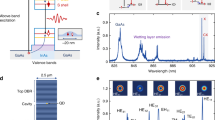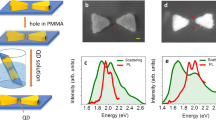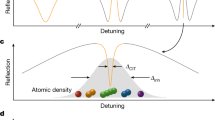Abstract
Non-resonant emitter–cavity coupling is a fascinating effect recently observed as unexpected pronounced cavity resonance emission even in strongly detuned single quantum dot–microcavity systems1,2,3. This phenomenon indicates strong, complex light–matter interactions in these solid-state systems, and has major implications for single-photon sources4,5,6 and quantum information applications1,2,3,7,9. We study non-resonant dot–cavity coupling of individual quantum dots in micropillars under resonant excitation, revealing a pronounced effect over positive and negative quantum dot mode detunings. Our results suggest a dominant role of phonon-mediated dephasing in dot–cavity coupling, giving a new perspective to the controversial discussions ongoing in the literature. Such enhanced insight is essential for various cavity-based quantum electrodynamic systems using emitters that experience phonon coupling, such as colour centres in diamond10 and colloidal nanocrystals11. Non-resonant coupling is demonstrated to be a versatile ‘monitoring’ tool for observing relevant quantum dot s-shell emission properties and background-free photon statistics.
This is a preview of subscription content, access via your institution
Access options
Subscribe to this journal
Receive 12 print issues and online access
$209.00 per year
only $17.42 per issue
Buy this article
- Purchase on Springer Link
- Instant access to full article PDF
Prices may be subject to local taxes which are calculated during checkout




Similar content being viewed by others
References
Hennessy, K. et al. Quantum nature of a strongly coupled single quantum dot–cavity system. Nature 445, 896–899 (2007).
Press, D. et al. Photon antibunching from a single quantum-dot–microcavity system in the strong coupling regime. Phys. Rev. Lett. 98, 117402 (2007).
Badolato, A., Winger, M., Hennessy, K. J., Hu, E. & Imamoglu, A. Cavity QED effects with single quantum dots. C. R. Physique 9, 850–856 (2008).
Michler, P. et al. A quantum dot single-photon turnstile device. Science 290, 2282–2285 (2000).
Kiraz, A., Atatüre, M. & Imamogˇlu, A. Quantum-dot single-photon sources: Prospects for applications in linear optics quantum-information processing. Phys. Rev. A 69, 032305 (2004).
Shields, A. J. Semiconductor quantum light sources. Nature Photon. 1, 215–223 (2007).
Bouwmeester, D., Ekert, A. & Zeilinger, A. The Physics of Quantum Information — Quantum Cryptography, Quantum Teleportation, Quantum Computation (Springer, 2000).
Reithmaier, J. P. et al. Strong coupling in a single quantum dot–semiconductor microcavity system. Nature 432, 197–200 (2004).
Peter, E. et al. Exciton-photon strong-coupling regime for a single quantum dot embedded in a microcavity. Phys. Rev. Lett. 95, 067401 (2005).
Park, Y.-S., Cook, A. K. & Wang, H. Cavity QED with diamond nanocrystals and silica microspheres. Nano Lett. 6, 2075–2079 (2006).
Le Thomas, N. et al. Cavity QED with semiconductor nanocrystals. Nano Lett. 6, 557–561 (2006).
Santori, C., Fattal, D., Vucković, J., Solomon, G. S. & Yamamoto, Y. Indistinguishable photons from a single-photon device. Nature 419, 594–597 (2002).
Yoshie, T. et al. Vacuum Rabi splitting with a single quantum dot in a photonic crystal nanocavity. Nature 432, 200–203 (2004).
Strauf, S. et al. Self-tuned quantum dot gain in photonic crystal lasers. Phys. Rev. Lett. 96, 127404 (2006).
Kaniber, M. et al. Investigation of the nonresonant dot–cavity coupling in two-dimensional photonic crystal nanocavities. Phys. Rev. B 77, 161303(R) (2008).
Naesby, A., Suhr, T., Kristensen, P. T. & Mørk, J. Influensce of pure dephasing on emission spectra from single photon sources. Phys. Rev. A 78, 045802 (2008).
Yamaguchi, M., Asano, T. & Noda, S. Photon emission by nanocavity-enhanced quantum anti-Zeno effect in solid-state cavity quantum-electrodynamics. Opt. Express 16, 18067–18081 (2008).
Auffèves, A., Ge´rard, J.-M. & Poizat, J.-P. Pure emitter dephasing: a resource for advanced solid-state single-photon sources. Phys. Rev. A 79, 053838 (2009).
Tarel, G. & Savona, V. Emission spectrum of a quantum dot embedded in a nanocavity. Phys. Status Solidi 6, 902–905 (2009).
Tawara, T. et al. Cavity mode emission in weakly coupled quantum dot–cavity systems. Opt. Express 17, 6643–6654 (2009).
Michler, P. et al. Quantum correlation among photons from a single quntum dot at room temperature. Nature 406, 968–970 (2000).
Suffczynski, J. et al. Origin of the optical emission within the cavity mode of coupled quantum dot–cavity systems. Phys. Rev. Lett. 103, 027401 (2009).
Bayer, M. et al. Fine structure of neutral and charged excitons in self-assembled In(Ga)As/(Al)GaAs quantum dots. Phys. Rev. B 65, 195315 (2002).
Stufler, S., Ester, P., Zrenner, A. & Bichler, M. Power broadening of the exciton linewidth in a single InGaAs/GaAs quantum dot. Appl. Phys. Lett. 85, 4202–4204 (2004).
Flagg, E. B. et al. Resonantly driven coherent oscillations in a solid-state quantum emitter. Nature Phys. 5, 203–207 (2009).
Muller, A. et al. Resonance fluorescence from a coherently driven semiconductor quantum dot in a cavity. Phys. Rev. Lett. 99, 187402 (2007).
Acknowledgements
The authors gratefully acknowledge financial support from the DFG research groups FOR 730 ‘Positioning of Single Nanostructures—Single Quantum Devices’ and FOR 485 ‘Quantum Optics in Semiconductor Nanostructures’. We also thank M. Emmerling and A. Wolf for expert sample preparation.
Author information
Authors and Affiliations
Contributions
S.R., A.L., S.H. and A.F. fabricated the sample structure. S.A., S.M.U., A.U. and P.M. conceived the experiments. S.A., S.M.U. and A.U. performed the experiments and analysed the data. S.A., S.M.U. and P.M. wrote the article, with input from the other authors.
Corresponding author
Supplementary information
Rights and permissions
About this article
Cite this article
Ates, S., Ulrich, S., Ulhaq, A. et al. Non-resonant dot–cavity coupling and its potential for resonant single-quantum-dot spectroscopy. Nature Photon 3, 724–728 (2009). https://doi.org/10.1038/nphoton.2009.215
Received:
Accepted:
Published:
Issue Date:
DOI: https://doi.org/10.1038/nphoton.2009.215
This article is cited by
-
Exciton–phonon interactions in nanocavity-integrated monolayer transition metal dichalcogenides
npj 2D Materials and Applications (2020)
-
Excitons in InGaAs quantum dots without electron wetting layer states
Communications Physics (2019)
-
Quantum-optical spectroscopy of a two-level system using an electrically driven micropillar laser as a resonant excitation source
Light: Science & Applications (2018)
-
Giant photon bunching, superradiant pulse emission and excitation trapping in quantum-dot nanolasers
Nature Communications (2016)
-
Scattering-induced dephasing of many-particle transitions in semiconductor quantum dots
Applied Physics B (2016)



